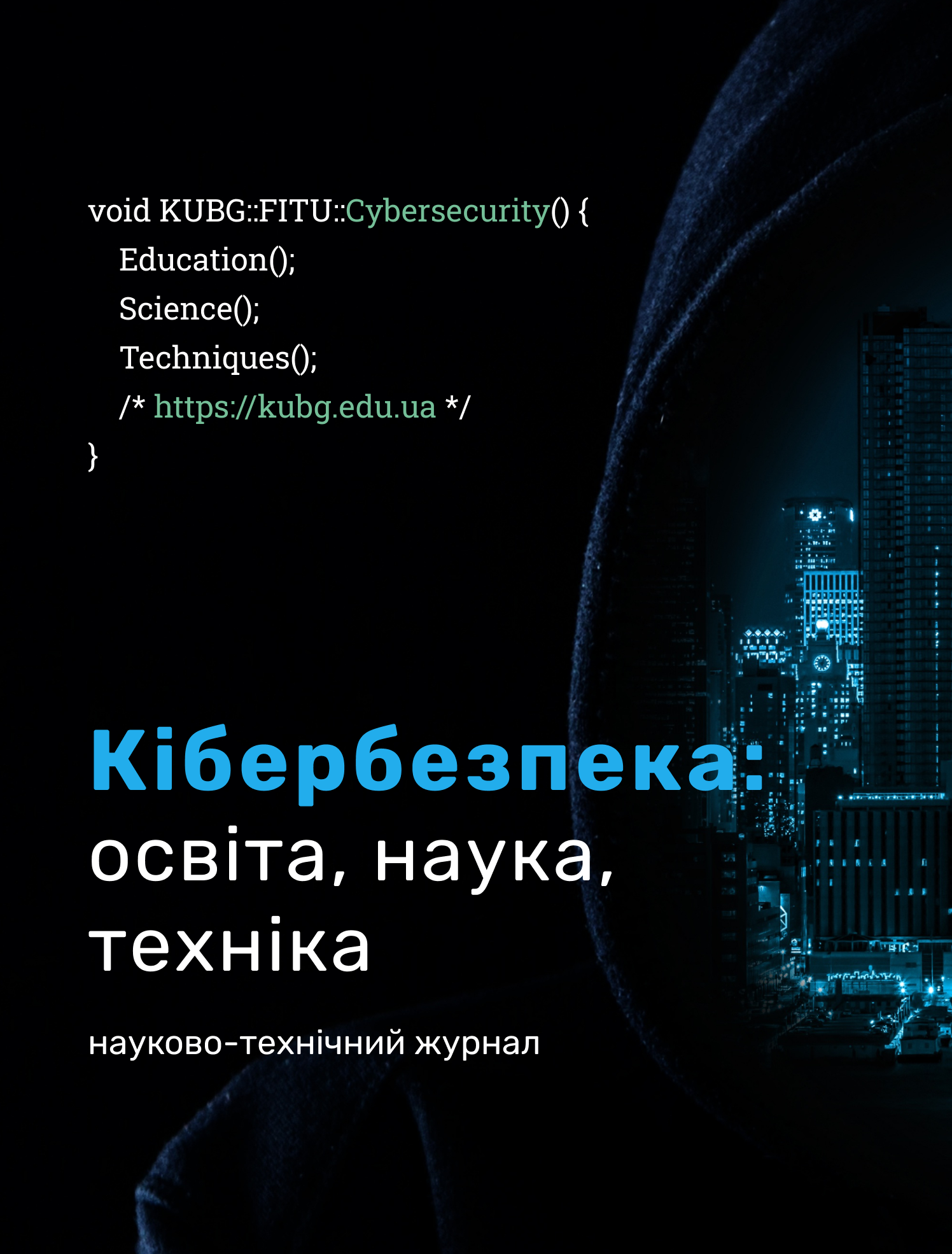METHOD OF DETECTION OF INFORMATION LEAKAGE BY REJECTING TRAFFIC FROM THE INFORMATION COMMUNICATION NETWORK
DOI:
https://doi.org/10.28925/2663-4023.2024.23.182198Keywords:
traffic deviation, method, model, forecasting, information technology, resilience, delay, privacy, availability, false information, personal dataAbstract
In the work, an analysis of the methods of detecting the leakage of language information was carried out. The analysis showed the absence of a single scientific methodical apparatus or automated software complexes to ensure the operational implementation of traffic analysis. Therefore, the work is devoted to information leakage detection based on the deviation of traffic from the information communication network.
An improved method of providing operational traffic analysis and informing about a suspicious situation is proposed. A situation that requires further detailed traffic analysis by automated software complexes or relevant specialists.
The developed method allows informing, in real-time, the responsible specialists about a possible leak of information, which is based on the analysis of the deviation of the nature of the traffic from the elements of the information speech network. Deviations, the nature of the traffic from the elements of the network parameters are measured relative to the usual traffic of the telephone or voice network relative to these parameters. A comparative analysis of normal traffic with real-time traffic is carried out.
This method further improves the methodology. The improvement was carried out due to practical recommendations regarding constant coefficients, and calculations. These coefficients for the improved method were chosen by calculation and empirically, which allows for a significantly reduced response of the traffic estimation system. This system uses the developed methodology to detect possible leakage of language information.
Downloads
References
Atassi, A., & Khalil, H. (1999). A separation princi ple for the stabilization of class of nonlinear systems. IEEE Trans. Automat. Control. 44(9), 1672–1687.
Tao, G., & Ioannou, P. (1993). Model reference adaptive control for plants with unknown relative degree. IEEE Trans. Automat. Control. 38(6), 976–982.
Laptev, O. (2019). Comparative analysis of methods of recognition of signals of radio equipment based on frequency transformations. Telecommunications and information technologies: a scientific journal, 3, 71–83.
Laptev, O., et al. (2019). Multi-agent technology for finding digital radio beacons based on bee colony clustering. Journal of Information Protection, 21(3), 194–202.
Laptеv, A., et al. (2019). The method of searching for digital means of illegal reception of information in information systems in the working range of Wi-Fi. International Journal of Advanced Research in Science, Engineering and Technology, 6(7), 10101–10105.
Laptіev, O., et al. (2019). Mathematical model of the information network structure based on non-stationary hierarchical and stationary hypernet. Collection of scientific works of the Military Institute of Taras Shevchenko Kyiv National University, 64, 124–132.
Kapustian, O., et al. (2022). Approximate Optimal Control for a Parabolic System with Perturbations in the Coefficients on the Half-Axis. Axioms, 11(4), 175. https://doi.org/10.3390/axioms11040175
Korchenko, A.O., et al. (2021). Development of a method for construction of linguistic standards for multicriterial evaluation of honeypot efficiency. Eastern-European journal of enterprise technologies, 1(2) (109), 14–23. https://doi.org/10.15587/1729-4061.2021.225346
Svynchuk, O. Et al. (2021). Image compression using fractal functions. Fractal and Fractional, 5(2), 1–14. https://doi.org/10.3390/fractalfract5020031
Laptiev, O., et al. Method of Detecting Radio Signals using Means of Covert by Obtaining Information on the basis of Random Signals Model. International Journal of Communication Networks and Information Security (IJCNIS), 13(1), 48–54.
Laptiev, O., et al. (2021). Method of Determining Trust and Protection of Personal Data in Social Networks. International Journal of Communication Networks and Information Security (IJCNIS), 13(1), 15–21.
Laptiev, O., et al. (2021). Improved model of estimating economic expenditures on the information protection system in social networks. Electronic Professional Scientific Edition “Cybersecurity: Education, Science, Technique”, 4(12), 19–28. https://doi.org/10.28925/2663-4023.2021.12.1928
Laptiev, O., et al. (2022). Method of Detecting Radio Signals using Means of Covert by Obtaining Information on the basis of Random Signals Model. International Journal of Communication Networks and Information Security (IJCNIS), 13(1). https://doi.org/10.17762/ijcnis.v13i1.4902
Barabash, O., et al. (2021). Comprehensive Methods of Evaluation of Distance Learning System Functioning. International Journal of Computer Network and Information Security (IJCNIS), 13(3), 62–71. https://doi.org/10.5815/ijcnis.2021.03.06
Laptiev, O., et al. (2022). The method of spectral analysis of the determination of random digital signals. International Journal of Communication Networks and Information Security (IJCNIS), 13(2). https://doi.org/10.17762/ijcnis.v13i2.5008
Laptievа, T. (2021). Algorithm for determining the measure of existence of unreliable information in the conditions of information conflict. Electronic Professional Scientific Edition “Cybersecurity: Education, Science, Technique”, 2(14), 15–25. https://doi.org/10.28925/2663-4023.2021.14.1525
Nakonechnyi, V., et al. (2022). Improving the method of detecting and clustering sources of false information. Scientific technologies, 54(4), 105–111. https://doi.org/10.18372/2310-5461.54.16747
Laptіeva, T., Lukova-Chuiko, N. (2022). Improvement of the method of detection of false information based on the method of expert evaluation “Delphi”. Scientific technologies, 55(3), 193–199. https://doi.org/10.18372/2310-5461.55.16901
Zamrii, I., et al. (2022). Algorithm of control and prediction of functional stability of complex information and technical systems. Telecommunications and information technologies, 1(74), 4–15.
Laptiev, S. (2022). An improved method of protecting personal data from attacks using social engineering algorithms. Electronic specialized scientific publication “Cybersecurity: education, science, technology”, 4(16), 45–62. https://doi.org/10.28925/2663-4023.2022.16.4562
Laptiev, S., & Tolupa, S. (2022). The methodology for evaluating the functional stability of the protection system of special networks. Information technologies, cyber security, 55(3), 178–183. https://doi.org/10.18372/2310-5461.55.16900
Korolkov, R., & Laptіev, S. (2022). Realistic simulation of a “war driving” attack on a wireless network. Electronic specialized scientific publication “Cybersecurity: education, science, technology”, 2(18), 99–107. https://doi.org/10.28925/2663-4023.2022.18.99107
Published
How to Cite
Issue
Section
License
Copyright (c) 2024 Сергій Глухов; Андрій Собчук, Володимир Ровда, Микола Половінкін, Віталій Пономаренко

This work is licensed under a Creative Commons Attribution-NonCommercial-ShareAlike 4.0 International License.




